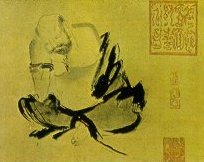



|
Lohan is an interesting subject matter among Buddhist paintings in China. In the last issue, we mentioned that the image of Guanyin is that of a young woman. In contrast to it, the image of Lohan is that of a middle-aged man. Lohan was originally known as Arhat in Sanskrit and Arahat in Pali. Literally, Lohan is a man of worth, honourable one. There are two kinds of arhats, namely, the Sound-hearing arhat and the Enlightened-to-condition arhat.The former attains the wisdom to understand the Four Noble Truth, while the latter attains the wisdom to understand the Law of Dependant Origination or the Twelve Links of Dependant Origination. They represent two vehicles, who "comprehend for their own sake". As they pay attention to themselves and not to others, they are incapable of genuine and equal enlightenment. There are four noble stages of fruition in the Arhat Path In the beginning, a lohan was a follower of the Buddha, an assistant by his side. When the image of Lohan was introduced to China, there were something like the 16 Lohans as the Buddha instructed 16 of his followers to live in the human world and present themselves in human forms. Later on the number grew to 18 Lohans and some even to 500 Lohans. During the Five Dynasties, the images of Lohans became very popular, since the mind is the Buddha and the Buddha is the mind and Buddhas and humans are in fact the same, and so is the human form of the Lohan. Lohan became more and more like an ordinary man and it is pretty much up to the imagination of the artists to depict whatever an image for him. The were also some interesting figures among the Lohans in China, such as the legendary Ji Gong, the Crazy Monk. Due to such human appeal, Lohan became a popular artistic form in Chinese Buddhist paintings.
|
|||||